Research on the Thermal Aging Characteristics of Cured Epoxy Resin Insulating Materials for DC Bushings
Abstract
:1. Introduction
2. Materials and Methods
- Pre-treatment of casting mold: Place the epoxy resin casting mold to be used into a vacuum drying oven for preheating for 2 h at a temperature of 80 °C. After preheating, remove the mold and apply an appropriate amount of release agent on the surface in contact with the epoxy resin, then place it back into the vacuum drying oven for heat preservation and standby.
- Pre-treatment of raw materials: Weigh the epoxy resin, curing agent, and accelerator according to the formula table, and place them in a vacuum drying oven at a temperature of 100 °C for drying and preheating for 0.5 h to obtain the dried liquid epoxy resin, curing agent, and accelerator for later use.
- Preparation of epoxy resin casting material: Place the dried and preheated epoxy resin and curing agent into a reaction vessel heated and insulated by a heat preservation sleeve for vacuum stirring. The stirring is carried out using a high-speed disperser at a speed of 350 r/min, and a vacuum pump is used for continuous vacuum treatment during the stirring process, with a stirring time of 30 min. After stirring, add the weighed accelerator to the reaction vessel and continue stirring for 3 min under the same conditions to obtain the epoxy resin casting material.
- Casting: Use the gravity casting method to pour the epoxy resin casting material into the prepared mold, and place the mold into a hot air drying oven for vacuum degassing treatment to remove the bubbles remaining in the resin and at the interface between the tree branch and the mold, with a vacuum treatment time of 5 min.
- Curing: After vacuum degassing treatment, restore the hot air drying oven to atmospheric pressure for 16 h. After curing is completed, demold to obtain the epoxy resin sample.
3. Test Methods
3.1. Thermal Aging Test
3.2. Insulating Performance Test
3.3. Heat Resistance Test
3.4. Mechanical Performance Test
4. Results and Discussion
4.1. Physical Performance of Cured Epoxy Resin
4.2. Insulating Performance of Cured Epoxy Resin
4.3. Thermal Performance of Cured Epoxy Resin
4.4. Mechanical Performance of Cured Epoxy Resin
4.5. Statistical Analysis of Performance Degradation of Epoxy Composite After Thermal Aging
5. Conclusions
- (1)
- The results of infrared spectroscopy show that the chemical bonds of cured epoxy resin materials are broken during the aging process, leading to surface degradation and consequently causing dimension shrinkage and mass loss of the cured epoxy resin. When the thermal aging temperature is 270 °C, after the tenth round of aging, compared with the unaged cured epoxy resin materials, the dimension shrinkage reaches 14.00%, and the mass loss reaches 20.52%.
- (2)
- Thermal aging destroys the microscopic surface structure of the cured epoxy resin, reducing its electrical properties. After the tenth round of aging at a thermal aging temperature of 250 °C, the breakdown strength of the cured epoxy resin decreases by 9.9% compared to before aging, and the volume resistivity also drops significantly. Under different aging temperatures, the dielectric constant and dielectric loss of the cured epoxy resin fluctuate with the progress of aging, but the variation amplitude is relatively small.
- (3)
- In the early stage of thermal aging, excessively high temperatures damage the crosslinked structure of the cured epoxy resin, causing a significant decrease in its flexural strength. However, as the oxidation layer forms on the surface of the cured epoxy resin, the penetration of oxygen is hindered, reducing the degree of internal aging of the cured epoxy resin, and thus the rate of decrease in its flexural strength tends to be gentle. Compared with the pre-aged cured epoxy resin, after ten rounds of aging at 250 °C and 270 °C, the flexural strength of the cured epoxy resin decreased by 39.79% and 53.91%, respectively.
Author Contributions
Funding
Institutional Review Board Statement
Data Availability Statement
Conflicts of Interest
References
- Yang, K.; Dai, J.; Zhao, W.; Wang, S.; Liu, X. Bio-based epoxy resin demonstrating high breakdown strength and low dielectric loss via intrinsic molecular charge traps construction. Compos. Part B Eng. 2024, 284, 111728. [Google Scholar] [CrossRef]
- Luo, Z.; Zhao, Y.; Bai, J.; Yang, K.; Xu, Y.; Ding, L.; Du, B. Peak-type charge barriers enabling high surface-insulating performance of epoxy composites. Compos. Sci. Technol. 2022, 2029, 109706. [Google Scholar] [CrossRef]
- Liu, Y.; Lin, Y.; Cao, B.; Wu, K.; Wang, L. Mechanism of the Polysiloxane Concentration-Dependent Hydrophobicity in Epoxy Resin Based on a Thermodynamic Ring Model With Saturation Effect. IEEE Trans. Dielectr. Electr. Insul. 2023, 30, 571–579. [Google Scholar] [CrossRef]
- Yoshimichi, O.; Naoshi, H. Thermal ageing of soft and hard epoxy resins. High Volt. 2022, 8, 12–20. [Google Scholar]
- Lou, S.; Wang, S.; Zhang, L.; Liu, J.; Tang, T. Intrinsic flame-retardant epoxy resin based on phosphorus-containing liquid imidazole compound: Simultaneously improving fire safety, mechanical property and heat resistance. Chem. Eng. J. 2024, 493, 152816. [Google Scholar] [CrossRef]
- Yang, Q.; Wang, J.; Chen, X.; Yang, S.; Huo, S.; Chen, Q.; Guo, P.; Wang, X.; Liu, F.; Chen, W.; et al. A phosphorus-containing tertiary amine hardener enabled flame retardant, heat resistant and mechanically strong yet tough epoxy resins. Chem. Eng. J. 2023, 468, 143811. [Google Scholar] [CrossRef]
- Luo, Z.; Wang, L.; Zhao, B.; Yin, F.; Li, J.; Cui, B.; Li, H.; Liu, Y. Hygrothermal aging mechanism of epoxy composites used for medium-frequency transformers. Polym. Degrad. Stab. 2024, 228, 110913. [Google Scholar] [CrossRef]
- Huang, Y.; Yi, L. Effect of Thermal Ageing on Dielectric Property of Epoxy Resin for Dry-typeransfo. Insul. Mater. 2016, 49, 53–56+60. [Google Scholar]
- Wang, Y.; Liu, Y.; Wang, S.; Xu, H. The Effect of Electrothermal Aging on the Properties of Epoxy Resin in DryType Transformer. Trans. China Electrotech. Soc. 2018, 33, 3906–3916. [Google Scholar]
- Liu, Y.; Lin, Y.; Wang, Y.; Wu, K.; Cao, B.; Wang, L. Simultaneously improving toughness and hydrophobic properties of cycloaliphatic epoxy resin through silicone prepolymer. J. Appl. Polym. Sci. 2022, 139, e52478. [Google Scholar] [CrossRef]
- Zhao, Y.; Xu, Y.; Yan, C.; Teyssedre, G.; Du, B. Evolution of Charge Trapping and Insulating Performances of Epoxy Materials Containing Hydrolyzable Chlorine During Hygrothermal Aging. IEEE Trans. Dielectr. Electr. Insul. 2022, 29, 1828–1837. [Google Scholar] [CrossRef]
- Liao, D.; Gu, T.; Yan, J.; Yu, Z.; Dou, J.; Liu, J.; Zhao, F.; Wang, J. Effect of thermal aging on the microscale mechanical response behavior of glass fiber/epoxy composites. J. Mater. Sci. 2024, 59, 15298–15314. [Google Scholar] [CrossRef]
- Shang, X.; Pang, L.; Tang, W.; Bu, Q.; Zhang, Q. Aging of epoxy cast insulation with different voltages and environmental stresses. J. Phys. D Appl. Phys. 2025, 58, 025502. [Google Scholar] [CrossRef]
- Zhang, M.; Sun, B.; Gu, B. Accelerated thermal ageing of epoxy resin and 3-D carbon fiber/epoxy braided composites. Compos. Part A Appl. Sci. Manuf. 2016, 85, 163–171. [Google Scholar] [CrossRef]
- Wang, Y.; Wang, S.; Huang, Y.; Yi, L.; Cai, Y. Study on Thermal Aging Characteristics of Epoxy Resin of Dry-type Transformer. High Volt. Eng. 2018, 44, 187–194. [Google Scholar]
- Jewell, B.; Abadi, P.P.S.; Sain, T. Experimental characterization and constitutive modeling of bulk epoxy under thermo-oxidative aging. Polym. Degrad. Stab. 2025, 234, 111215. [Google Scholar] [CrossRef]
- Deng, Y.; Wang, Q.; Ma, J.; Oh, J.T.; Chen, Z. The combined impact of voids and thermal aging on the mechanical reliability of epoxy resin evaluated by statistical analysis. Polym. Degrad. Stab. 2023, 215, 110455. [Google Scholar] [CrossRef]
- Starkova, O.; Gaidukovs, S.; Platnieks, O. Prediction of viscoelastic properties of epoxy/graphene oxide nanocomposites: Time-temperature-water ageing superposition. Polym. Degrad. Stab. 2023, 214, 110400. [Google Scholar] [CrossRef]
- Zhou, L.; Min, X.; Fu, A.; Chen, J.; Chen, S.; Xia, Y.; Zhao, C.; Wang, D. Study on hydrophobicity and aging characteristics of epoxy resin modified with nano-MgO. e-Polymers 2024, 24, 20240067. [Google Scholar] [CrossRef]
- Wu, Y.; Xun, L.; Huang, S.; Ren, C.; Sun, B.; Gu, B. Crack spatial distributions and dynamic thermomechanical properties of 3D braided composites during thermal oxygen ageing. Compos. Part A Appl. Sci. Manuf. 2021, 144, 106355. [Google Scholar] [CrossRef]
- GB/T 11026.1-2016; Electrical Insulating Materials—Thermal Endurance—Part 1: Ageing Procedures and Evaluation of Test Results. Standards Press of China: Beijing, China, 2016.
- Marouani, S.; Curtil, L.; Hamelin, P. Ageing of carbon/epoxy and carbon/vinylester composites used in the reinforcement and/or the repair of civil engineering structures. Compos. Part B Eng. 2012, 43, 2020–2030. [Google Scholar] [CrossRef]
- Luo, Z.; Zhao, Y.; Li, X.; Liu, Y.; Zhang, S.; Xu, Y. Synergistic Enhancement of Toughness and Rigidity of Epoxy Compositesby 2-Toluene Glycidyl Ether. Proc. CSEE 2024, 44, 2485–2496. [Google Scholar]
- Yang, K.; Zhao, Y.; Liu, X. Enhanced breakdown strength of epoxy composites by constructing dual-interface charge barriers at the micron filler/epoxy matrix interface. Compos. Part B Eng. 2024, 283, 111602. [Google Scholar] [CrossRef]
- Yang, K.; Chen, W.; Zhao, Y.; Ding, L.; Du, B.; Zhang, S.; Yang, W. Enhancing dielectric strength of thermally conductive epoxy composites by preventing interfacial charge accumulation using micron-sized diamond. Compos. Sci. Technol. 2022, 221, 109178. [Google Scholar] [CrossRef]
- GB/T 1408.1-2016; Insulating Materials—Test Methods for Electric Strength—Part 1: Test at Power Frequencies. Standards Press of China: Beijing, China, 2016.
- GB/T 1410-2006; Methods of Test for Volume Resistivity and Surface Resistivity of Solid Electrical Insulating Materials. Standards Press of China: Beijing, China, 2006.
- GB/T 1409-2006; Recommended Methods for the Determination of the Permittivity and Dielectric Dissipation Fator of Electrical Insulating Materials at Power, Audio and Radio Frequencies Including Meter Wavelengths. Standards Press of China: Beijing, China, 2006.
- ISO 11357-2-2014; Plastics—Differential Scanning Calorimetry (DSC)—Part 2: Determination of Glass Transition Temperature and Glass Transition Step Height. International Organization for Standardization: Geneva, Switzerland, 2014.
- ISO 11358-2014; Plastics-Thermogravimetry (TG)—Part 2: Determination of the Activation Energy. International Organization for Standardization: Geneva, Switzerland, 2014.
- ISO 11358-2014; Test Methods for Properties of Resin Casting Body. Standards Press of China: Beijing, China, 2008.
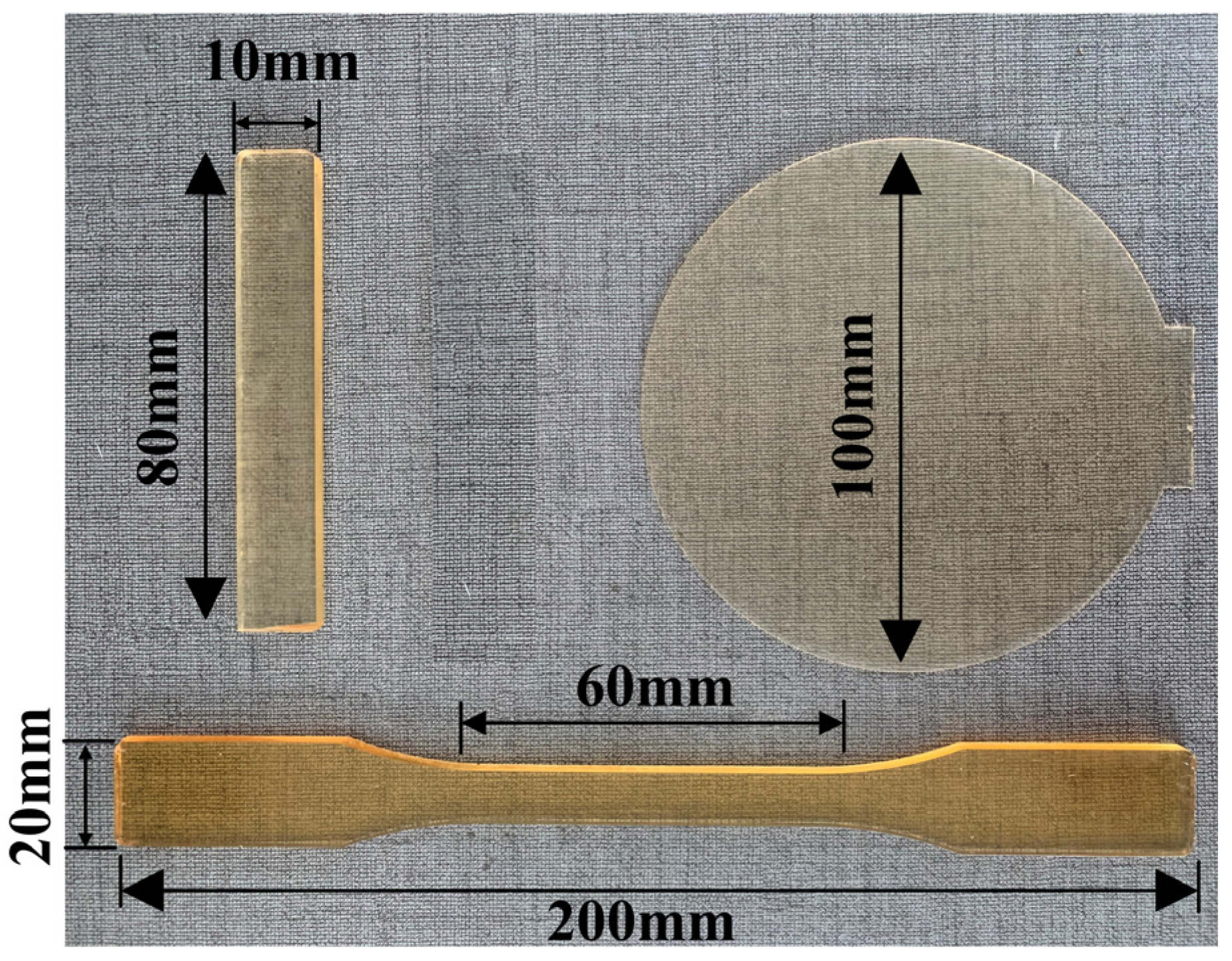



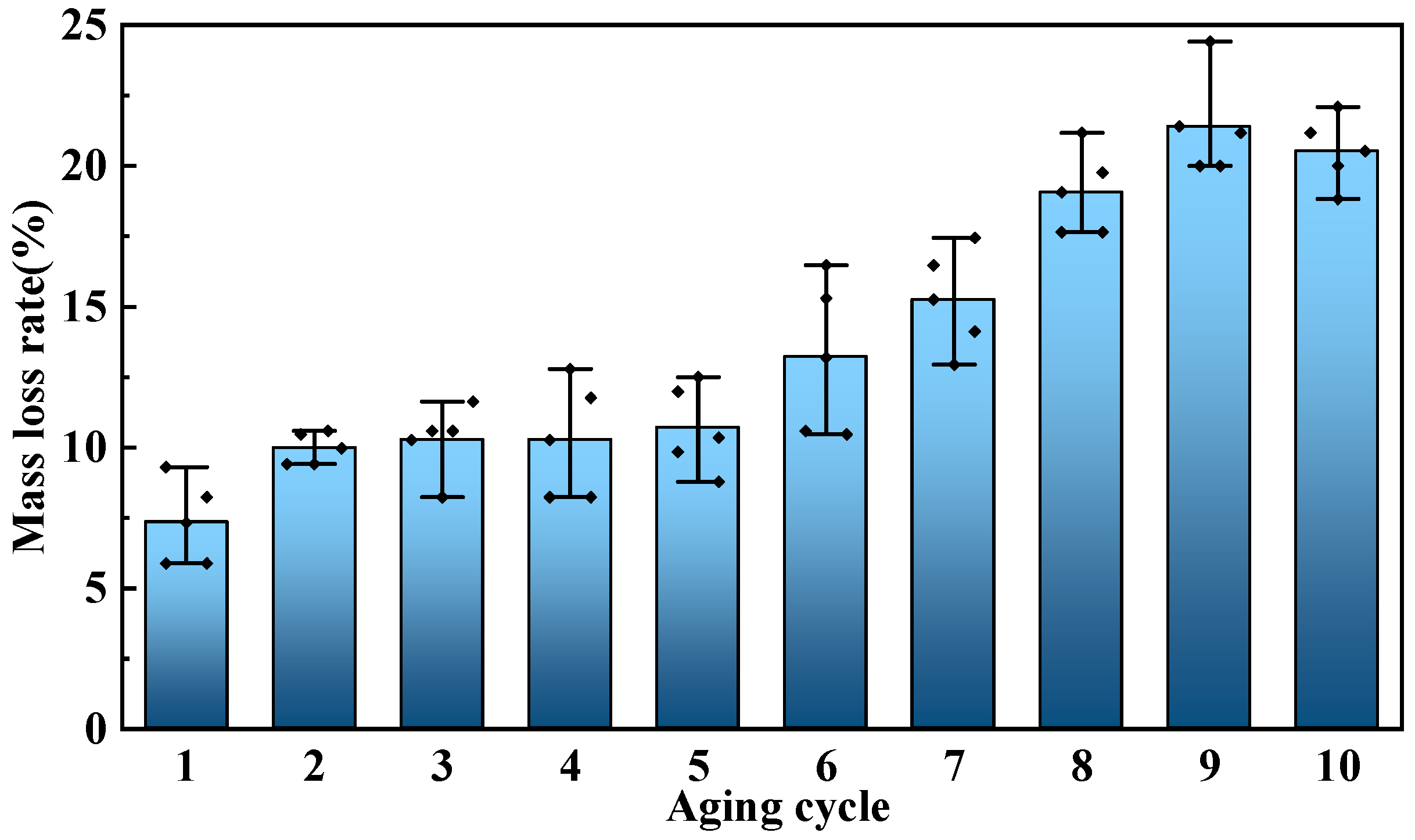

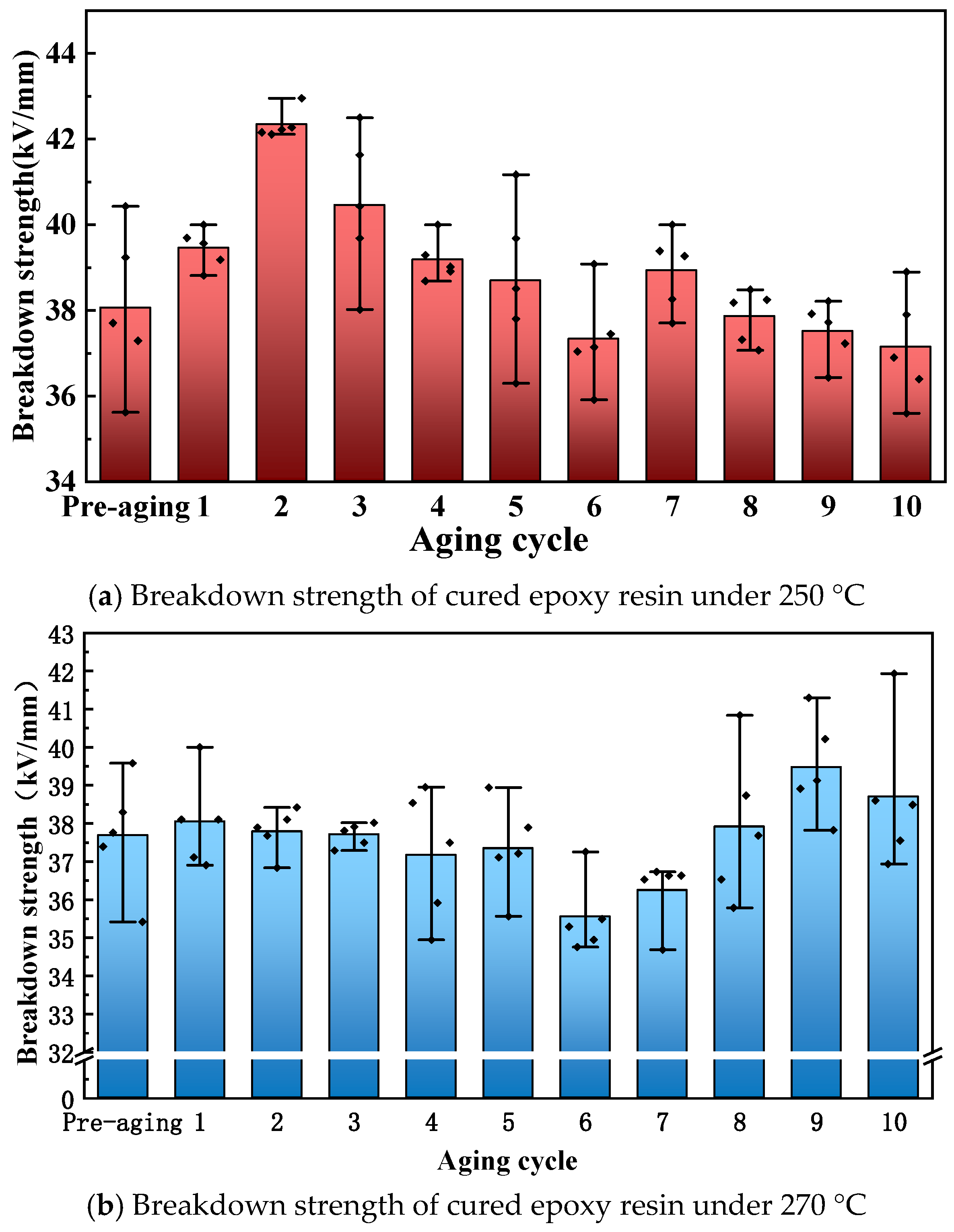
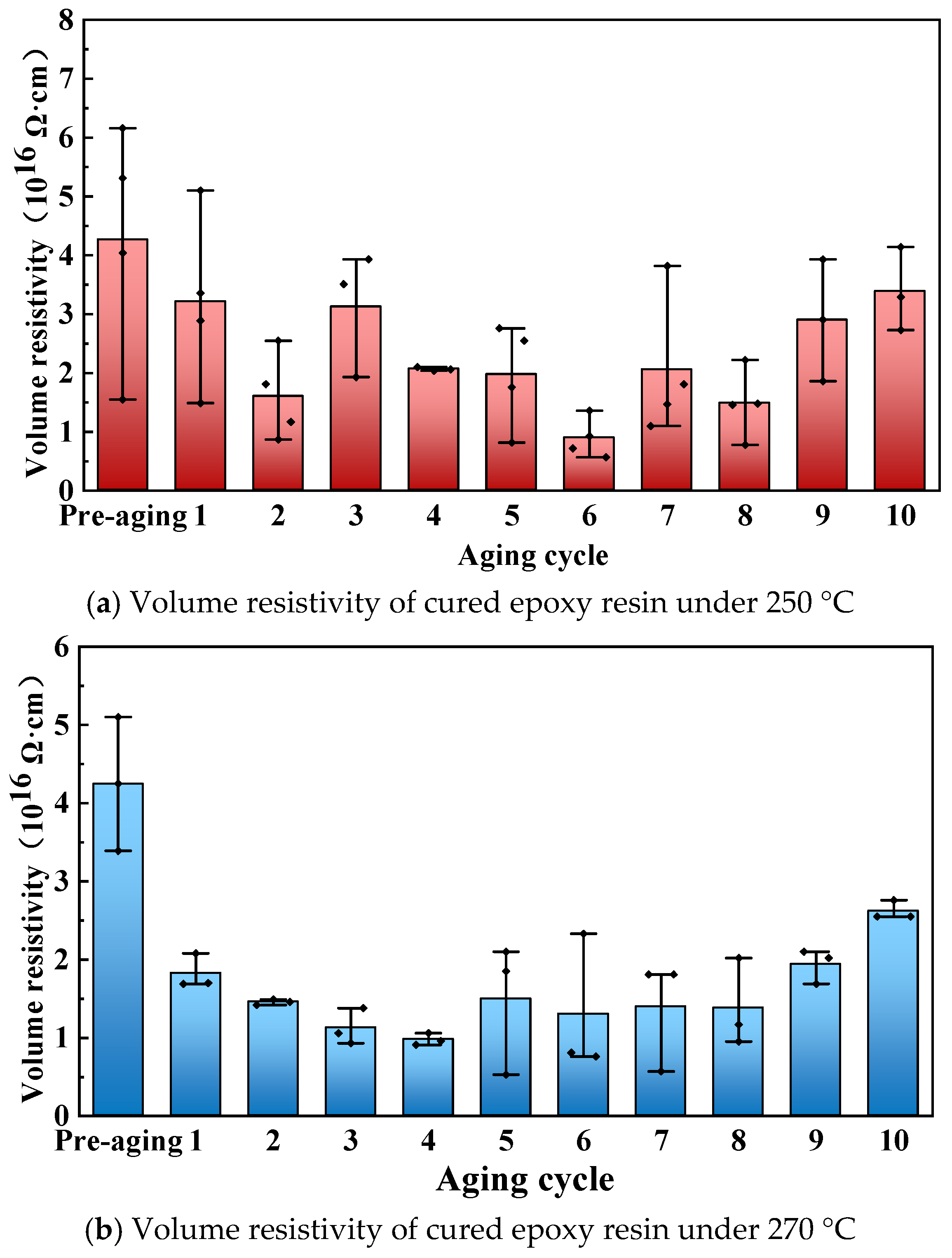
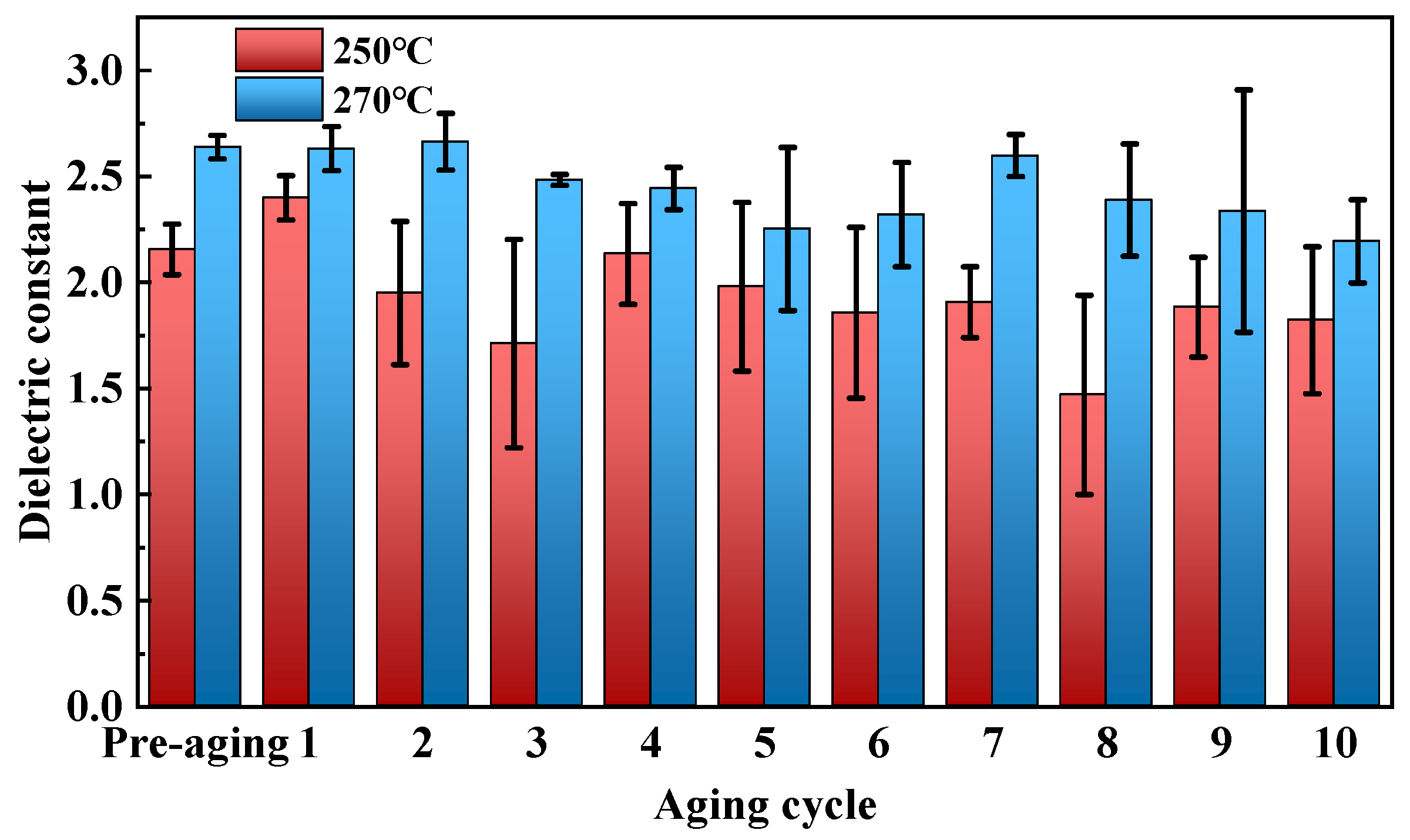


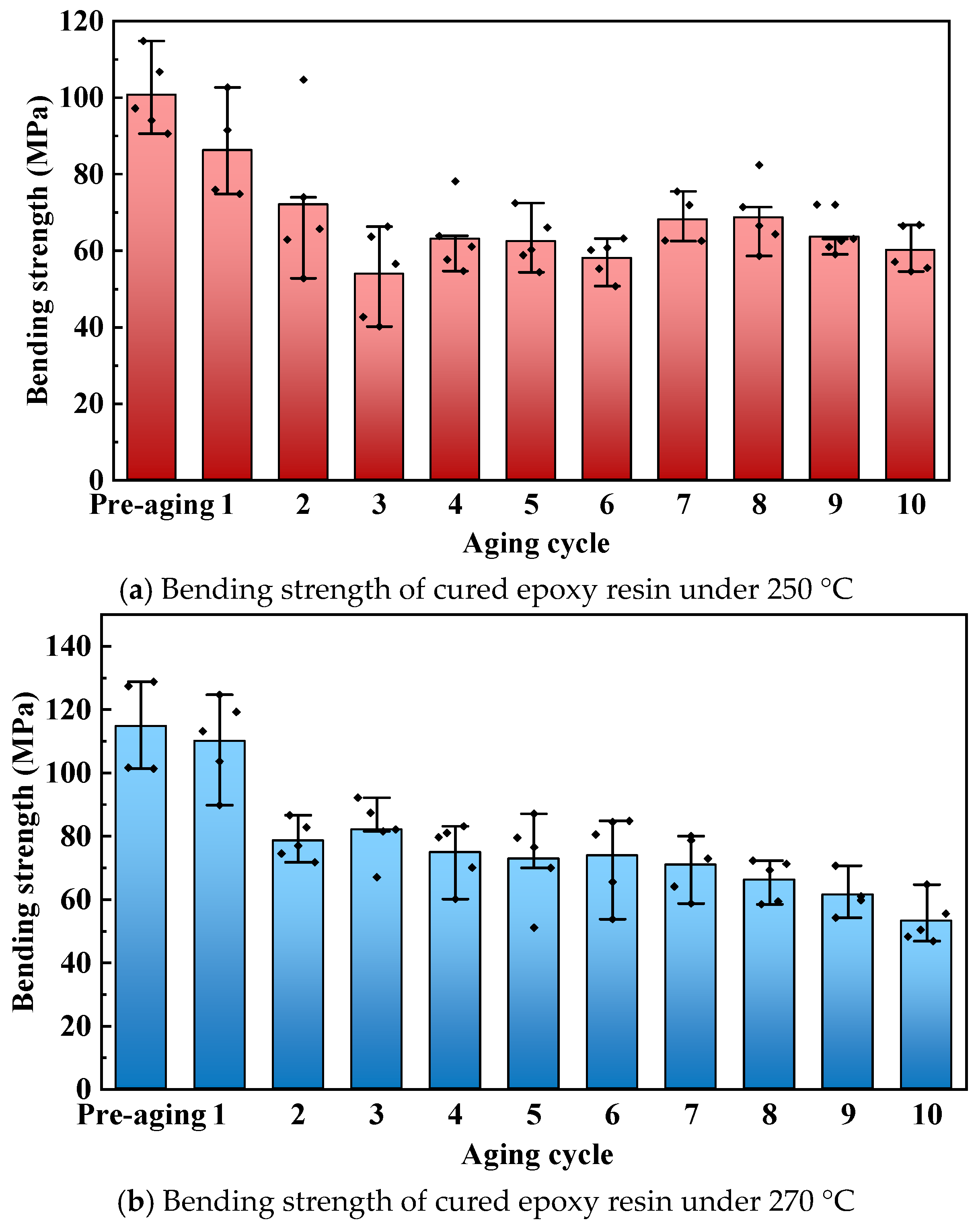

| Source | Tg (°C) | Aging Test Procedure | Changes in Key Performance |
|---|---|---|---|
| [4] | 121 | 120 °C/2500 h | 5.44% increase in flexural strength |
| [13] | 114.9 | 80 °C/168 h | 11.43% increase in AC breakdown electric field strength |
| [14] | 110 | 90 °C/384 h | 9% increase in compression |
| 110 | 120 °C/384 h | 7% reduction in compression | |
| [16] | 140 | 160 °C/720 h | 73.33% reduction in tensile strength |
| Name | Category | Specification | Origin |
|---|---|---|---|
| Bisphenol A Diglycidyl Ether | Epoxy Resin | Chemical Grade | Shanghai Kingchem Co., Ltd. (Shanghai, China) |
| Phthalic Anhydride | Curing Agent | Analytical Grade | Shanghai Macklin Biochemical Technology Co., Ltd. (Shanghai, China) |
| Hexahydrophthalic Anhydride | Curing Agent | Analytical Grade | Shanghai Macklin Biochemical Technology Co., Ltd. (Shanghai, China) |
| Tetrahydrophthalic Anhydride | Curing Agent | Analytical Grade | Shanghai Macklin Biochemical Technology Co., Ltd. (Shanghai, China) |
| 2-Toluene Glycidyl Ether | Modifier | Chemical Grade | Shanghai Macklin Biochemical Technology Co., Ltd. (Shanghai, China) |
| N,N-Dimethylbenzylamine | Accelerator | Chemical Grade | Shanghai Macklin Biochemical Technology Co., Ltd. (Shanghai, China) |
| Number | Epoxy Resin (g) | Blended Curing Agent (g) | 2-Toluene Glycidyl Ether (g) | BDMA (g) |
|---|---|---|---|---|
| EP-HTP | 100 | 81.8 | 0 | 0.6 |
| EP-HTP-5 | 100 | 86.5 | 5 | 0.6 |
| EP-HTP-10 | 100 | 91.1 | 10 | 0.6 |
| EP-HTP-15 | 100 | 95.8 | 15 | 0.6 |
| Temperature (°C) | Diameter Before Aging (mm) | Diameter After 1 Cycle of Aging (mm) | Diameter Shrinkage Rate After 1 Cycle of Aging (%) | Diameter After 10 Cycles of Aging (mm) | Diameter Shrinkage Rate After 10 Cycles of Aging (%) |
|---|---|---|---|---|---|
| 250 | 100 | 98 | 2.00 | 87 | 13.00 |
| 270 | 100 | 97 | 3.00 | 86 | 14.00 |
| Aging Cycles | T5% (°C) | T10% (°C) | TMAX (°C) | Rw (%) | ||||
|---|---|---|---|---|---|---|---|---|
| 250 | 270 | 250 | 270 | 250 | 270 | 250 | 270 | |
| Pre-aged | 361.25 | 367.71 | 379.3 | 388.25 | 403.64 | 417.21 | 1.26 | 1.57 |
| 1 | 377.76 | 361.81 | 387.39 | 387.1 | 401.95 | 424.81 | 0.2 | 1.31 |
| 4 | 381.92 | 370.23 | 388.93 | 392.58 | 407.93 | 413.67 | 0.14 | 1.31 |
| 7 | 366.51 | 391.9 | 387.8 | 405.12 | 404.8 | 419.21 | 0.14 | 0.99 |
| 10 | 373.66 | 401.69 | 389.3 | 412.79 | 407.11 | 430.54 | 0.13 | 0.84 |
Disclaimer/Publisher’s Note: The statements, opinions and data contained in all publications are solely those of the individual author(s) and contributor(s) and not of MDPI and/or the editor(s). MDPI and/or the editor(s) disclaim responsibility for any injury to people or property resulting from any ideas, methods, instructions or products referred to in the content. |
© 2025 by the authors. Licensee MDPI, Basel, Switzerland. This article is an open access article distributed under the terms and conditions of the Creative Commons Attribution (CC BY) license (https://creativecommons.org/licenses/by/4.0/).
Share and Cite
Liu, D.; Tong, X.; Liu, L.; Chen, T.; Tang, J.; Tang, W.; Wang, L.; Cao, B.; Luo, Z. Research on the Thermal Aging Characteristics of Cured Epoxy Resin Insulating Materials for DC Bushings. Polymers 2025, 17, 1064. https://doi.org/10.3390/polym17081064
Liu D, Tong X, Liu L, Chen T, Tang J, Tang W, Wang L, Cao B, Luo Z. Research on the Thermal Aging Characteristics of Cured Epoxy Resin Insulating Materials for DC Bushings. Polymers. 2025; 17(8):1064. https://doi.org/10.3390/polym17081064
Chicago/Turabian StyleLiu, Daijun, Xiaobang Tong, Libao Liu, Tao Chen, Jiarong Tang, Wenkai Tang, Liming Wang, Bin Cao, and Zimin Luo. 2025. "Research on the Thermal Aging Characteristics of Cured Epoxy Resin Insulating Materials for DC Bushings" Polymers 17, no. 8: 1064. https://doi.org/10.3390/polym17081064
APA StyleLiu, D., Tong, X., Liu, L., Chen, T., Tang, J., Tang, W., Wang, L., Cao, B., & Luo, Z. (2025). Research on the Thermal Aging Characteristics of Cured Epoxy Resin Insulating Materials for DC Bushings. Polymers, 17(8), 1064. https://doi.org/10.3390/polym17081064






